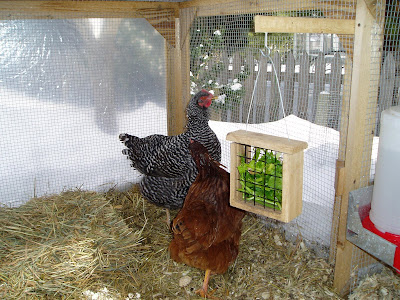
It’s hard to write a blog post about gardening in winter, and not just because there are fewer gardening chores to write about. It’s depressing, for me, anyway, to look out the window and see a foot or more of snow on the ground. It snowed last night, yesterday, and the day before, just an inch or so here and there, but enough to remind me that the annual nightmare we call winter is not going away yet.
Even the chickies seem to have the mid-winter blues. They run to the door of their pen eagerly when I open it, then stand in the doorway staring at the snow. Eventually, they walk away, beaks down, back into their little pen, defeated by yet another dreary day with a yard full of snow upon which they refuse to walk.
I returned mid-February from a trip to southern California to soak up some sunshine and visit relatives. I thought a mid-winter trip would provide a break and make the winter seem shorter. When I get back, I thought, it will be time to start seedlings under grow lights and in a few weeks, the snow cover will have melted.
With fantasies like these, you’d never know I spent much of my life in the Midwest. I grew up in Kansas and Illinois. I left when I was 18, but returned to the Midwest in my mid-thirties, living in Nebraska until about 6 years ago when I moved to Wisconsin. So I do have some inkling of what a Midwestern winter entails. Yet every year I delude myself into thinking “it’s nearly over” long before it is.
Wisconsin is by far the coldest part of the Midwest that I’ve lived in. There are many things I love about Wisconsin, the lush forests, the abundant lakes (when I moved here, one proud Wisconsin resident informed me that, although Minnesota bills itself as the “land of 10,000 lakes," Wisconsin actually has more), the plentiful wildlife – but winter is not one of them.
After experiencing my first winter here, I so dreaded the next one that the following autumn, I had low-level anxiety attacks as winter drew near. Over the years, I’ve become less anxious at the onset of winter, but I haven’t learned to like it. I wish I could. Some people here love winter sports – like cross-country skiing or ice fishing. My sister Donna and her friend Trish love to go on the night-time candle-lit hikes along snowy trails offered by some state parks.
If, like me, you love the outdoors, but don’t enjoy winter sports, the season drags on because you just spend it waiting for the weather to improve! And if one of your favorite outdoor activities is gardening, you’re really in for a long wait – followed by a frenzy of activity to get everything going to make the most of a short season.
Ironically, the wait was made more trying by the trip to California. It was hard not to be envious of the bountiful winter gardens, with gorgeous large heads of cauliflower and broccoli, peas trained up fences, and luxuriant lettuces. I failed completely to contain my jealousy at the sight of citrus trees loaded with fruit, what are to Midwesterners “exotic” trees like avocado growing in people’s back yards, and huge rosemary shrubs (my very favorite herb – which can’t survive the harsh Wisconsin winters.)
The good news (and there is a cheerful spot in this otherwise gloomy post!) is that the weather is subtly changing. The biting cold is past and the air is sweet, with the barest whiff of spring. I hear many more birds than I did a month ago. And I can start my spring gardening soon!
Mid-March is when I start tomato, eggplant, chili, and bell pepper seedlings under lights. I’ll start some lettuce and spinach, too, but they’ll get planted out earlier than the warm weather loving solanaceae family of plants. I plan on pruning my fruit trees and raspberries next month as well.
In April I’ll plant potatoes, peas, and carrots directly in the garden and start squashes and melons indoors, as well as herbs like parsley and cilantro. Like the chickens, I can’t wait to start scratching in the soil!